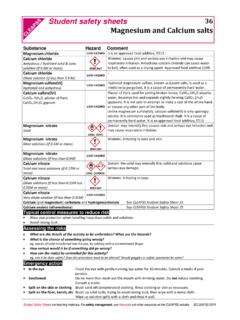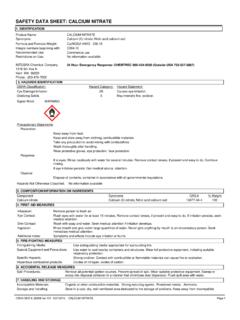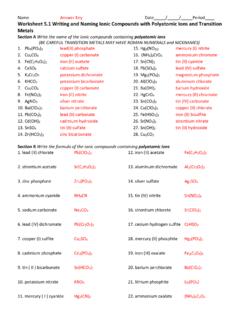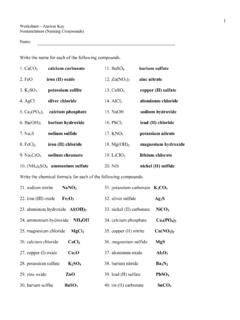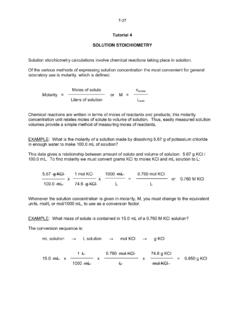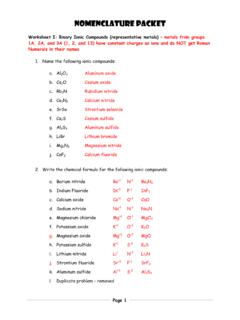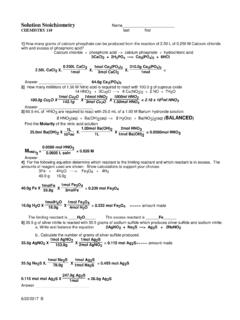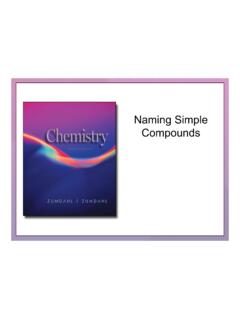Transcription of Nitrogen: All Forms Are Not Equal - Cornell University
1 1 nitrogen : All Forms Are Not Equal Summary: By understanding the different chemical Forms of nitrogen , you can manage root-zone pH and avoid toxic buildup of ammonium. Neil Mattson, Assistant Professor and Floriculture Extension Specialist, Cornell Roland Leatherwood, Postdoctoral Associate, Cornell Cari Peters Peters Inc. nitrogen form Plants have the ability to take up several chemical Forms of nitrogen . The most common are: ammonium (NH4+), which has a positive charge; nitrate (NO3-), which has a negative charge; and urea, ((NH2)2CO), which has no charge.
2 Many commercial fertilizer mixes contain a combination of all three nitrogen Forms . When these nitrogen Forms are added to the growing medium natural processes can take place that convert one form to another (Figure 1). Bacteria can convert urea to ammonium or ammonium to nitrate . Hydrogen ions (H+) which acidify the medium are released when ammonium is converted to nitrate . In growing medium urea is converted to ammonium very quickly in less than two days. Urea and ammonium are typically grouped together and referred to as ammoniacal nitrogen .
3 When roots take up charged molecules, such as ammonium or nitrate , they typically release an identically charged molecule to maintain a balanced pH inside the plant cells. Because nitrogen can be supplied as a positively or negatively charged form, the root substrate pH can be altered. Reprinted from the June 2009 Edition of GMPro Magazine Figure 1. Conversions between nitrogen form and effect of nitrogen uptake on root-zone pH. 2 pH effect Plants take up ammonium and other positively charged cations by releasing one hydrogen ion (H+) into the medium solution for each ammonium ion absorbed.
4 Over time, ammoniacal nitrogen uptake increases hydrogen ion concentration thereby lowering the growing medium pH. The uptake of negatively charged anions such as nitrate is most often accomplished by releasing hydroxide ions (OH-). In the medium solution, hydroxide and hydrogen ions combine to form water (H2O). Over time the reaction of hydroxide and hydrogen ions decreases hydrogen ion concentration and increases the medium pH. Under some circumstances plants absorb a nitrate anion by simultaneously absorbing hydrogen ions or releasing bicarbonate.
5 Like hydroxide ions, bicarbonate combines with hydrogen ions and thus raises the medium pH. The net effect of using a nitrate -based fertilizer is to increase the overall medium pH. A dramatic example of the effect of nitrogen form on growing medium pH is shown in Figure 2. Rose plants were grown hydroponically in a nutrient solution containing different percentages of ammonium. During the first day after nitrogen addition, the pH dropped by one to two units as bacteria converted ammonium to nitrate .
6 After the initial pH drop, pH increased over time in the 8 percent and 16 percent ammonium treatments as only nitrate was left to be absorbed by the plants. In the 31 percent ammonium treatment, a combination of ammonium and nitrate was taken up by roots over the next five days which kept pH fairly steady. These effects are much more dramatic than what would occur in a commercial growing medium as it is somewhat buffered due to its chemical properties and added limestone. Selecting a fertilizer The ratio of nitrate to ammoniacal nitrogen in a fertilizer determines the rate of substrate pH change and can even be used to correct pH during production.
7 The pH changing property is known as a fertilizer s potential acidity or basicity and is listed on a fertilizer s label (Table 1). Figure 2. Change in pH of the root-zone of rose plants provided with three different percentages of ammonium. 3 Table 1. Some commercially available fertilizers, their percentage of total nitrogen as nitrate or ammonium plus urea, and potential acidity or basicity a. Fertilizer NO3 NH4 b Potential acidity c or basicity d Ammonium sulfate 0 100 2200 a Urea 0 100 1680 a 21-7-7 acid 0 100 1539 a 21-7-7 acid 0 100 1518 a Diammonium phosphate 0 100 1400 a Ammonium nitrate 51 49 1220 a Monoammonium phosphate 0 100 1120 a 18-9-18 708 a 20-20-20 532 a 21-5-20 407 a 20-10-20 404 a 20-10-20 60 40 401 a 21-5-20 60 40 390 a 17-5-17 106 a 20-0-20 54 46 0 15-0-20 38 b 15-5-15 80 20 69 b 15-5-15 131 b 15-0-14 165 b 15-0-15 221 b 15-0-15 319 b calcium nitrate 100 0
8 400 b Potassium nitrate 100 0 520 b Sodium nitrate 100 0 580 b a Table adapted and revised from Paul Nelson: Greenhouse Operation and Management. p. 315. 6th ed. Prentice Hall. New Jersey. b The percentage of total N in the ammonium plus urea Forms ; remaining N is nitrate c Potential acidity is defined as the pounds of calcium carbonate limestone required to neutralize the acidity of 1 ton of fertilizer d Potential basicity: applying 1 ton of this fertilizer has the pH neutralizing effect of this many pounds of calcium carbonate limestone 4 High pH can be corrected by switching to a more acidic fertilizer.
9 One example is 21-5-20 fertilizer which has a potential acidity of about 400. Application of 1 ton of 21-5-20 causes acidification which would require 400 pounds of calcium carbonate limestone to counteract. Similarly, 15-0-15 has 420 pounds of potential basicity and can be used to increase a low pH. For crops that are known to have issues with pH decline (such as zonal geraniums), using a nitrate -based fertilizer such as 15-5-15 may aid in slowing or stopping pH decline over time. The greater the potential acidity or basicity, the more pH change occurs.
10 Ammonium toxicity Often nitrogen is applied at concentrations greater than plants can readily absorb. Plants can take up and store additional nitrogen to use later if nitrogen becomes limiting. nitrate can be safely stored by plants; but when plants take up and store too much ammonium, cell damage can occur. Luckily, under normal conditions of warm temperatures and a well aerated medium, urea and ammonium are converted to nitrate by nitrifying bacteria so there is little worry about excess ammonium in the medium.

